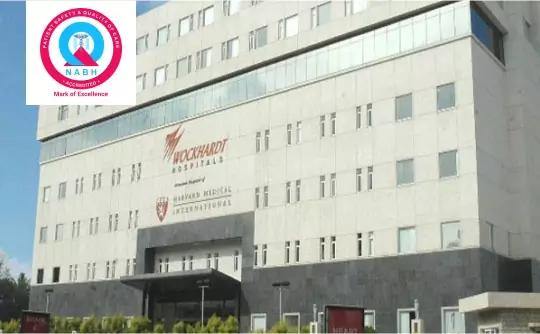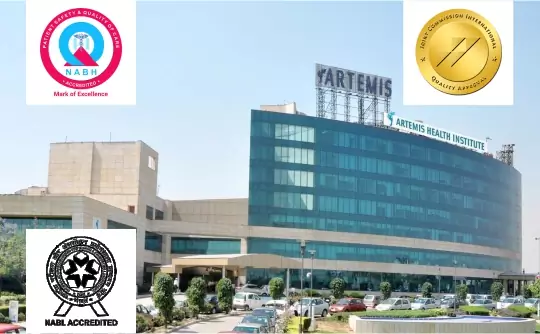

Limb Lengthening Cost in India starts from US $5,000 and varies depending on your medical condition and history, surgeon, hospital, and the city where you choose to get the surgery done.
An important expense when it comes to your limb lengthening cost in India is going to be your orthopedic surgeon's fees. IndiCure recommends highly experienced, skilled, board-certified surgeons who are capable of delivering successful surgeries. Although the charges may vary depending on the experience of the surgeon, you are assured to be in safe hands with IndiCure.
A significant portion of the overall cost of limb lengthening surgery arises from the type of surgical approach to perform the surgery- whether an external or internal fixator is being used. The other factor is the use of any customized surgical instruments or specialized technology. With the hopes of improving patient care, new techniques and technologies are often introduced to the surgical process. Such innovative advancements in the surgical approach can increase costs.
Having your limb lengthening surgery in an accredited surgical facility by skilled and qualified medical staff is a critical factor. Moreover, the geographical location of this facility also affects the quote. But, IndiCure provides you with a projected estimate that will be all inclusive and affordable.
The surgery-related expenses include the pre- and post-surgical expenses. The pre-surgical expenses are associated with the candidacy and the medical history of the patient. This also includes the routine medical exams and tests to ensure you're a good fit for the surgery. Post-surgical expenses can include prescription medications, physical therapy, rehabilitation stay, and follow-up consultations.
We at IndiCure, understand that you travel with a budget in mind and do not like to be greeted by surprises after arrival in India. We thus club all these expenses and give you the package cost that is inclusive and affordable at the same time.
Your case manager shall give you an estimated cost of your surgery after discussing your medical reports with the surgeon. The final cost, however, shall be confirmed after your consultation with the surgeon.
In fact, we have Special Negotiated Rates with the Hospitals and you can avail Discounted Rates when you choose to Travel with IndiCure.


We Help you Choose the Right Treatment, Surgeon & Hospital

We Arrange Video/Telephonic Consultation with the Surgeon

We Assist you with Visa & Accommodation

We Receive you at the Airport and Drop you at Hotel/Hospital

We Assist you the at Hospital & Provide Post Operative Support

Mumbai
Wockhardt Hospitals is the branch of the leading Wockhardt pharmaceutical company in India. The company is more than four decades old and is present in more than 20 countries around the globe. Wockhardt has 9 hospitals in India in Mumbai, Nagpur, Rajkot, Nashik, and Surat.

Gurgaon
Artemis Health Institute, a premium multi-specialty hospital is a healthcare venture launched by the promoters of the Apollo Tyres Group. Established in 2007, Artemis was the first hospital in Haryana to get NABH accreditation within 3 years of start-up.
Limb lengthening is a treatment that entails extending the bones in the arms and legs. This is done in stages so that the bones and soft tissues (skin, muscles, nerves, and so on) gradually lengthen.
The procedure usually takes many months. Limb lengthening can be paired with deformity repair, either progressive or acute. The humerus (upper arm bone), radius/ulna (forearm bone), femur (thigh bone), tibia (shin bone), and metatarsals (foot bones) are all routinely lengthened.
The doctor will cut the bone into two separate parts during surgery. An osteotomy is a surgical technique that involves cutting a bone.
To prepare the muscles and nerves for lengthening, further soft-tissue treatments may be performed at the same time. The Achilles tendon, for example, could be surgically lengthened to make tibial (shin bone) lengthening easier. An orthopedic lengthening device will also be applied to the bone by the doctor.
Internal devices, such as the Precice nail, are orthopedic lengthening devices that are placed into the bone. External fixators, such as the Taylor Spatial Frame or the Ilizarov device, are orthotic lengthening devices that remain outside of the body.
External Fixator- A metal frame called an external fixator rests outside the leg and is fastened to the bone using wires, screws, and pins. To extend the distance between the two sections of the leg bone that were sliced, the external fixator can be adjusted from the outside.
Internal Lengthening Nail- A motorized metal nail or rod called an internal lengthening nail is introduced into the leg bone's bone marrow cavity. A magnet inside the nail is rotated under control by a remote control device.
The bones are allowed to rest for five to seven days after surgery to allow the healing process to commence. Latency period is the name given to this period of time. Following the latency period, the patient will adjust the orthopedic device so that the two bone segments are slowly pulled apart. The gradual separation of the two bone segments is known as distraction, which literally means "drawing apart." New bone grows in the area between the two bone segments as they are gently forced apart. This new bone extends the bone's overall length. Regenerate bone is the name given to the new bone.
The patient (or a family member) adjusts the orthopedic device every day during the distraction phase such that the bone segments are moved apart at a slow rate of about 1 mm (0.04 inches) every day. This rate may vary slightly depending on the bone. The treatment plan can be to distract 0.75 mm every day in the tibia but 1.0 mm per day in the femur or humerus, for example. The body is forced to constantly produce new bone and soft tissues such as skin, muscles, nerves, and blood vessels as a result of this gradual distraction. The distraction phase lasts until the required length of the bone has been achieved.
Each month, you can gain about 1 inch (2.5 cm) in length. During the distraction phase, the patient will need to see the doctor many times a month to ensure that the bone is not lengthening too quickly or too slowly. The rate of distraction may be accelerated or slowed depending on the look of the regenerate bone on an X-ray. The patient will need to go to physical therapy two to five times per week during the distraction process.
The metal lengthening device will remain in place after the desired length is reached for several months so that the bone can finish healing and solidifying. In a subsequent outpatient surgery, the lengthening device will be removed.
Once the new bone has fully developed, it has the same strength as other bones and is not more susceptible to deterioration or fracture.
Many people who are candidates for leg lengthening surgery have two legs or arms that are different lengths due to:
Leg lengthening surgery may be appropriate for patients with skeletal dysplasias or other bone diseases. Other disorders that can result in a substantial leg length disparity that necessitates leg lengthening surgery are:
Many patients also choose this operation to increase their height by a few inches.
If you are suffering from any of the above deformities or are looking to increase your height, are otherwise in good health, you may be a candidate for limb lengthening surgery.
We at IndiCure completely understand your concerns and it is always our endeavor to provide the best outcome for every patient. Following is the list of questions you must ask before you embark on your journey for limb lengthening in India.
Prepare to answer questions about your:

The first part of the operation involves an osteotomy in which the leg bone that needs to be lengthened is cut. Depending on where the length discrepancy originates, your femur, the upper leg bone, or tibia, the lower leg bone, may be cut.
Your leg will then be stabilized using metal external, internal, or a combination of external and internal fixation devices, and the lengthening device will be inserted with a bone drill and metal pins, plates, screws, and wires.
Leg lengthening has a 95% success rate with minimal scarring as a result of the small incisions used to access the leg bones.
Recovery time from the limb lengthening procedure varies among patients, with the consolidation phase sometimes lasting a considerable period - especially in adults. As a general rule, children heal in half the time as it takes for adult patients. In adults, although bone healing takes longer, the use of the internal lengthening nail makes the process more simple as there is no external fixator needing to be worn.
Throughout recovery, physical therapy plays a crucial role in keeping the patient's joints flexible and in maintaining muscle strength. Patients are advised to eat a nutritious diet and to take calcium supplements.
To hasten bone healing, gradual weight-bearing is encouraged and the patient takes supplements like vitamin D3 and calcium to hasten bone healing.
If an arm or leg length difference of more than 2cm exists, limb lengthening surgery is indicated. Even simple things like walking or driving can become difficult due to a disparity in arm or leg length.
Many patients, however, choose this operation to increase their height by a few inches. Leg lengthening surgery is growing increasingly popular in India among both Indian and international patients.
In elite Indian facilities, limb lengthening surgery has a very high success rate. However, many doctors advise patients to avoid the treatment unless it is their final resort because it is fraught with risks. The risk of infection following surgery is high, and the patient may not always achieve the desired results with just one procedure.
The operation is carried out under general anesthesia. As a result, the patient will experience no pain during the procedure. The surgery will cause inflammation and agony in the operated area, just like any other medical procedure. The doctor suggested medication to help with the pain and soreness.
Orthopedic physicians do not suggest more than 3 inches of lengthening in one bone due to high complication rates. The highest thigh bone expansion that a patient can have is 2-3 inches (femur).
Patients between the ages of 18 and 25 who have achieved excellent bone growth are candidates for limb lengthening surgery. The operation may be conducted on elderly persons in rare situations. However, if the bones stop growing, a doctor may suggest leg-shortening or leg restriction surgery.
A bone is normally lengthened 2 inches (5 cm) or less throughout each lengthening treatment. To make the total lengthening 4 inches, 2 inches of lengthening can be done concurrently in the femur (thigh bone) and the tibia (shin bone) (2 inches in the femur and 2 inches in the tibia).
In more severe situations, more lengthening may be achievable in a single treatment. Children and adults with big lengthening objectives, for example, may be able to tolerate more than 2 inches of bone lengthening. Our surgeons assess this on a case-by-case basis.
Before they become 16, some children receive three different lengthening treatments to enhance their length. This is frequently combined with other procedures (deformity correction, epiphysiodesis).
After limb lengthening adults and children can usually lead normal, active lifestyles. The majority of patients have improved function (better walking/gait), muscle strength, and range of motion (flexibility) after the procedure.
Experienced surgeons, support staff, and physical therapists collaborate with motivated patients at every level of the procedure, which is critical to success.
Physical therapy is a key aspect of lengthening; patients may need to attend many physical therapy sessions per week to maintain range of motion (flexibility) and muscular strength throughout the distraction phase.
Prosthetic management is another possibility. In rare circumstances, a prosthesis can be customized to a patient's deformed limb to increase movement. Amputation of the shorter limb is sometimes necessary. While this may appear severe, amputation is the best option for many people. With prosthetic limbs, many patients who had amputations are now running around, participating in competitive athletics, or simply doing the things that kids do.
The surgeons will split the bone in your shorter limb before inserting the lengthening rod there. At both ends of the rod, the bone will be fixed to the rod. Following surgery, you will trigger the rod using a device that rests on your leg so that the bone will gradually extend and separate a little bit each day.
Rods are attached to each side of the divided bone by the external fixator, the TL Hex External Fixator System. To the rings fastened to the outside of your arm, these rods are joined. The rings and the bone will gradually split and extend as you crank the struts holding the rings together each day. Your limb will be supported by the frame, and the rods will promote bone growth.
Depending on how much your limb needs to develop, you will need to wear the frame for a specific amount of time. Regardless of the method, it typically takes six to nine months for patients to recover enough to resume running and jumping after surgery.
In reality, the first few months are when the majority of bone lengthening occurs. Following that, it takes time for the bone to completely mend and for your strength to return to normal.
Getting back to a normal routine as soon as you have had some time to recover after your operation is crucial. Your daily exercises and stretching your legs become a routine part of your day. You'll resume your regular activities, including attending school.
With a lengthening rod, you won't be able to fully bear your weight on the lengthened leg and will need crutches to get around until the bone is almost fully healed. After a few weeks, you won't need crutches if you have an external fixator because the frame will support your entire body weight.
You will visit the doctor every week while your leg is being lengthened, but once it is, you will only need to do so once a month.
Though limb lengthening surgery is quite effective, there are hazards associated with leg lengthening surgery, including the following:
An inflatable rod is inserted inside the bone as an internal lengthening device. The rod contains a magnetic gearing system. The inside gadget is gradually lengthened using a portable remote control that is placed on top of the skin and another magnet.
In general, limb lengthening procedures are very successful (about 95 percent ). Since most operations only need tiny incisions, scarring is typically minimal. Serious consequences following limb lengthening surgery are uncommon, despite the possibility of minor issues with pins and stiffness in the joints.
You or your child would need assistance in using crutches, a walker, or a wheelchair for around 6 to 8 weeks following surgery. During this period, you shouldn't put any weight on the leg that has the internal lengthening device.
Patients can begin physically demanding activities like jogging, leaping, and weightlifting after the extended bones are fully consolidated and with the doctor's approval (6 to 12 months after surgery).
At two years following surgery, patients who underwent bilateral aesthetic tibial lengthening can anticipate a nearly full recovery from daily activities and minor sports.
Aesthetic operations are highly expensive in the US and many other European nations, yet they may be performed just as well and for much less money in India. Not only the surgeons are equally qualified and experienced, they can talk in English, hospitals are accredited and the cost of limb lengthening surgery is a fraction of what it would cost you in the US or Europe.
Traveling abroad for medical reasons may be challenging. With our experience of over a decade and working with the best surgeons and top hospitals in India, we help make your medical tour easier and safer for you. We will guide you at every step of the way and make end-to-end arrangements for your surgery, travel, and stay.
Ramandeep Dhaliwal
I had great experience having rhinoplasty through Indicure. Dr. Ruchika from Indicure has helped me in finding best plastic surgeon, answering all my questions...
Read More
Joshua Archer
My name is Joshua Archer I'm from New Zealand, bay of plenty, kawerau I opted for the bypass surgery in January 2023 but planned it in advance for 28 September found IndiCure...
Read More
Kera Ren
Absolutely loved my experience with IndiCure - from first inquiring to meeting the surgeon pre op to my follow up post op. The surgeon was extremely approachable...
Read More
Andreana Paul
Had a wonderful experience. Visited India for my plastic surgery. From sending mails, airport pickup, comfortable accommodation and, to smooth hospital appointment booking...
Read More
Brandi Luce
I had the privilege of using Indicure's services for a cosmetic procedure that I had wanted for a long time but had always been apprehensive about. Ruchika helped me...
Read More
Jade M
Indicure Health Tours went above and beyond my expectations. They helped me with every aspect of my journey and were professional, kind and caring. I was...
Read More
The content on the website (www.indicure.com) is intended to be general information and is provided only as a service. It is not medical advice and should not be taken as medical advice. It should not be used to diagnose or treat a health condition and is in no way meant to be a substitute for professional medical care.
All photographs on our website of before and after results are examples only, and do not constitute an implied or any other kind of certainty for the result of surgery. You are advised to see a surgeon in person to assess what surgery may or may not accomplish for you.
It is also important to keep your expectations realistic and to understand that all surgical procedures carry risks and should never be taken lightly.